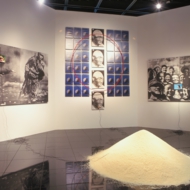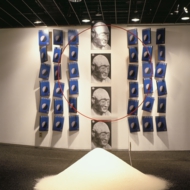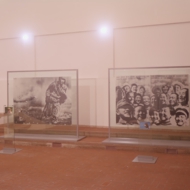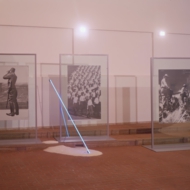
The grave at midday - Japan
1995, photo, rice, steel, few photos quoted from magazine Front, Nippon and Shanghai
New Asian Art Show 1995, The Japan Foundation Forum, Tokyo Japan
Photo by Light On
2001, photo, glass, steel, rice, neon light, few photos quoted from magazine Front
Ikiro- Be alive / Contemporary Art from Japan
Kröller - Müller Museum, the Netherland
Photo by Cary Markerink
Jaap Bremer(former deputy director of the Kröller-Müller Museum in the Netherlands
The text is quoted from the exhibition catalogue of ikiro- be alive, is published by the Kröller-Müller Museum in the Netherlands.
Minako Saitoh is one of the young Japanese artists with an acute awareness of the times and society in which they live. Two themes dominate her work: people and time.
‘One of the most important aspects of my work is based on my interest in people, their relationships, and the things they create. I feel that Japanese society today tends to obscure our awareness of truly being alive. In order to consider one's consciousness of life, I think it is necessary to examine death. Death is a proof of the existence of life.’ (…) ‘Time is another important element of my work. I am interested in the fact that the time that has been allotted to me and through which I will pass is representative of a human life. It is the accumulation of such individual flows of time that results in mankind's histories and gives birth to myths. By looking at the commonplace acts that people repeat throughout history, I believe that we can see the essence of human life,’ Saitoh writes.
In order to materialize and express her perceptions of people and time in her work, Minako Saitoh uses everyday objects and events as metaphors for human existence and the passing of the time. The numerous photographs in her installations are meant to illustrate the latter aspect. The people , society and history addressed in her work are her own Japanese environment and Japanese history.
The Grave at Midday-Nippon in this exhibition is about Japan's wartime history and its role of aggressor in other Asian countries such as China and Manchuria in the latter half of the 1930s. The photos come from a propaganda magazine circulated by the Japanese government in Japan to justify and glorify the onslaught. The cover of Nippon magazine is repeated dozens of times on central panel, in the middle of which is the head of the Chinese monk Gang-Jing, who brought Buddhism to Japan from China in the sixth century B.C.. This photo and the huge mountain refer to elements of the everyday life of all Asian peoples, including the Japanese. Another of the work's themes is the massive military presence in Japan during the war, people's automatic obedience in this situation and the degree of individual guilt in the manner in which the war was conducted, a subject on which the older and younger generation of Japanese people hold widely differing views.
The installation Memory reflects the people and society of our times. It consists of a large number of used futons. These thin Japanese mattresses are an unambiguous reference to human life: the bed is where people are born, die and make love.
This version of Memory – Saitoh makes new versions of her installations for every occasion – is combined with photographs of the view from a psychiatric hospital. Saitoh: ‘While the aforementioned photos would express people's mental conditions, the mattresses would specifically be a metaphor for our bodily natures. It could also be understood as something that stores the memories of a person's life. In my view, the ceaseless universal acts of people, as well as the continuous flow of time, could be fully expressed through this material.’



